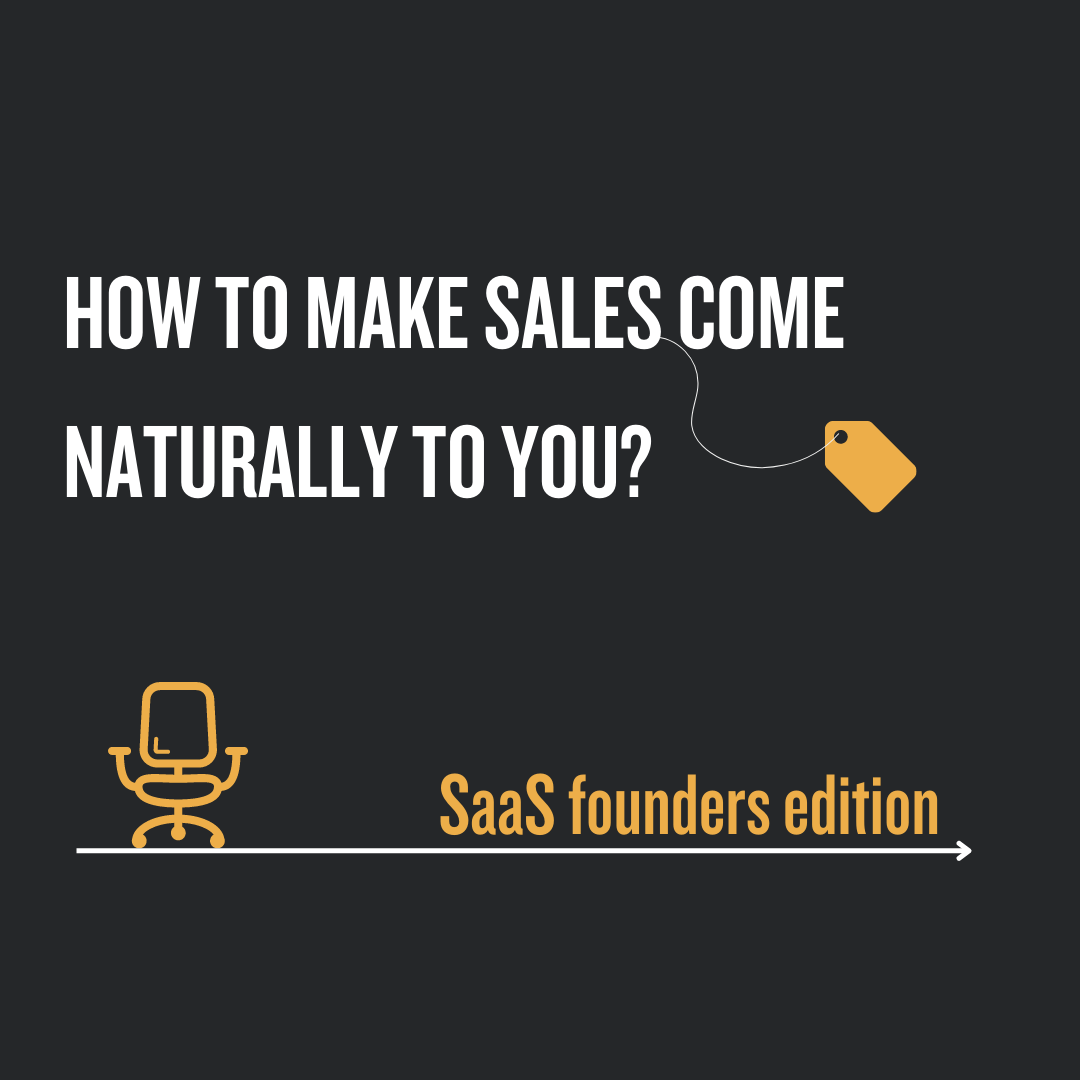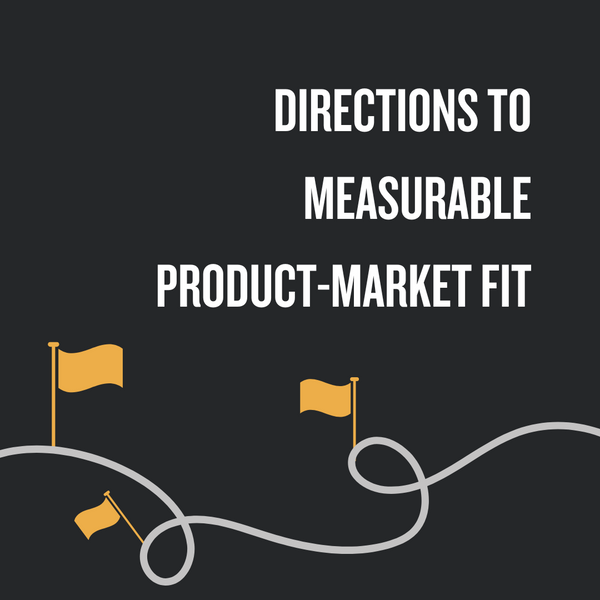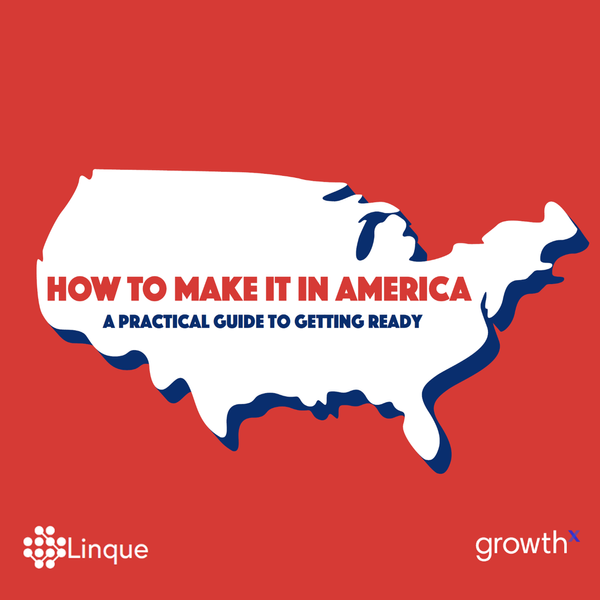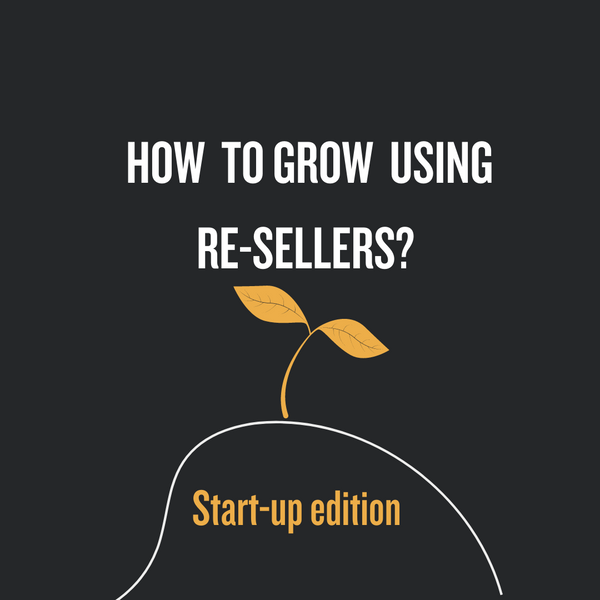In this article, I'll replace the preconceived notions that might be stopping you to excel at sales with 7 mindsets that will make sales come naturally to you.
Jim Rohn once said you shouldn’t wish that things were easier; you should wish that you were better.
Mindset 1: Own your mission
Let’s face it: one of the reasons you founded a startup is that you’re a misfit in some way. You aren’t satisfied with something in the world the way it is, and you want to make it better.
Embrace that mission.
From the execution point of view, your mission has mainly two parts:
- Build the product/service.
- Get more and more people to use that product/service – aka sales.
Luckily for us, we’re living in the best possible time for startups – it’s easier than ever before to bring your product to market. You can set up almost for free, thanks to countless companies offering services from company formation to cloud hosting. Up till a few years ago, this would have cost you thousands of dollars!
Along with costs, the entire approach toward starting a company has changed.
During most of the last century, the main question when starting a business was: “Can you build the product?” The great founders of this period were the ones who could envision a better way of doing things and building it.
However, over the last decade, developing a product has become more democratized. So, unless you’re working on some cutting-edge next-gen tech, the question for most businesses today is: “Should you build the product?” Today’s successful founders are the ones who can envision a better way of doing things and sell it.
They reject the old belief that “If I build it, they will come.”
Instead, they think, “If they come, I will build it.”
The fact is that most present-day startups fail not because they can’t build a product but because they can’t sell it.
And yet, so many founders I see are excessively focused on the product. Most of their daily and weekly activities revolve around building the product rather than building sales.
They forget that in today’s world, almost anyone can build similar products – and that their primary mission won’t be achieved until a lot of people/companies actually adopt their product, thus changing something for the better.
Owning it is the first step to achieving your true mission.
Mindset 2: Always be learning
It’s very important for you as a founder to understand and differentiate between the two learning curves you have to deal with at the same time:
- Your personal learning curve.
- Your startup’s learning curve.
Your personal learning curve is about ‘you’ learning to be a better founder, a better leader, and above all a better salesperson.
Your startup’s learning curve is focused on learning about your target customers, their problems, different ways to solve these specific problems, and above all how to better sell this specific product/service.
The goal is to build a systematic and predictable sales system that you can later scale to have a successful startup. Once you have the first version of this system, you can further improve it by optimizing, automating, and thus ultimately reducing the cost of acquiring each customer.
In this phase, learnings are more important than results.
If you make ten sales right away but you have no idea why then you can’t repeat them.
On the other hand, if you get just two sales but you know how to replicate them, then you’re golden – you can ramp things up.
In other words, you have to follow the sales learning curve, a concept described in detail in this Harvard Business Review article.
The authors, who have 25 years of experience with startups and new product launches, explain that increasing your sales force too quickly is a bad idea (although it may be very tempting!). Your top priority should be to learn how your customers will buy and use the product – a process called the sales learning curve.
This learning can only take place as customers start to acquire and use your product. Based on that new knowledge, you can modify your sales and marketing process to work better – and then expand your sales team.
If you hire too many salespeople before you understand how to sell your product efficiently, you’ll drain your cash reserves and still fall short of revenue expectations.
So, don’t hire a VP of Sales until you’re ready to scale, build and fund a small but growing sales team.
During the learning process, the velocity and cost of your experimentation are key. It’s all about getting to the truth of your ideas as quickly and cheaply as possible.
For this, you’ll need to experiment continuously.
Running experiments like Scrum can be very helpful. While Scrum is typically used in software development, it works pretty great in marketing as well. You can prioritize using three key variables – potential, importance, and ease. With frameworks like Scrum, you can:
- Identify mistakes early and nip them in the bud.
- Get things done and receive valuable feedback.
- Increase predictability while staying flexible.
- Set tangible goals.
To get a better sense of how Scrum can be used in marketing efforts, have a look at this case study, which explains how the content and marketing teams at Kaarten Carrousel used and tweaked it for greater success.
Mindset 3: Be a helper.
The only way to get what you want in life is to give people what they want.
The whole reason behind your startup is that you want to improve something for someone. Sales are simply the process of showing and convincing people who have a problem that your product/service can solve.
Remember, nobody cares how great you or your product are until they understand how you can help them solve the problem they think they have.
In other words, your job as a salesperson is to teach, coach, share and ultimately help.
You’ve got to see yourself as an expert and mentor. Your clients might know more about their businesses overall, but you definitely know more about the domain of the problem your product is solving.
You know how other companies are solving it, you know what works and what doesn’t, and you know about other solutions in the market – all in much more detail than your customer does.
You’ve also got to learn how to sell without being overly aggressive. The act of pushing your product to customers actually prevents you from making sales.
While shopping at a store, have you ever been asked by a salesperson: “Can I help you with something?”
You probably replied with: “No, thanks. I’m just browsing.”
You’re obviously visiting the store with the intention of buying something – but you still don’t like being followed around by the salesperson.
Why is that?
It’s because you think that the salesperson will start pushing you to buy something you don’t need or like. You feel they’re more interested in scoring a commission rather than genuinely helping you.
Are you making the same mistake as that salesperson with your potential customers?
The truth is that while people love to buy things, they hate being sold.
Buyers actively resist or ignore sellers who are pushy, seeing them as manipulative and even sleazy. When salespeople make everything about closing the sale and not what the customer needs, they risk losing the sale altogether. What’s more, they risk never seeing the customer again.
That’s what makes the sales game really tricky.
While doing sales is essential for your success, you’ve also got to get it right – otherwise, you could end up turning potential customers away.
The best salespeople quickly build trust by acting as helpers rather than sellers. For them, it isn’t mainly about selling – it’s about helping clients succeed.
Remember, customers want to buy – and great salespeople make the purchase easier by informing and helping the buyer.
If you help clients to make smart decisions that are in their best interest, sales will follow.
A majority of B2B sales people long ago switched from selling product features/functions to selling solutions.
There’s also the Challenger sales model, which can help you get potential customers to think about issues that affect their business, in new and unfamiliar ways.
If you think about it, you’re actually helping people through sales every day – your spouse, your kids, your friends, your neighbors, your colleagues, your employees…
You’re basically selling them your views, opinions, and suggested plans of action. Apply that attitude of helpfulness to your startup sales as well.
When your primary aim is to help, not just sell your product, here’s what needs to happen:
- You listen to your customer’s problem first, instead of presenting your solution right off the bat.
- You mentor and coach your potential customers, helping them realize their real problem vs. the problem they think they have.
- When customers are open to you and trust you, they give you insights into their problems.
- Once you have insights into their problems, you can quickly show them how your product solves their problem.
- Also, you might realize that your product can’t solve the problem of a particular potential customer. In that case, simply be honest and say, “Our solution isn’t designed to solve this problem, but you could connect with XYZ company.”
Mindset 4: Interrupting is good
In order to help, you need to interrupt.
Your ideal clients are out there, waiting for you to solve a problem for them.
But they aren’t just going to come to you. You need to go to them, interrupt their day, and let them know you’re there to help.
I know that most of the time as a startup founder, you probably feel like the guy selling wheels in the picture below.
You’ve got the wheels, but your potential customers are too busy dragging their stuff to pay attention!
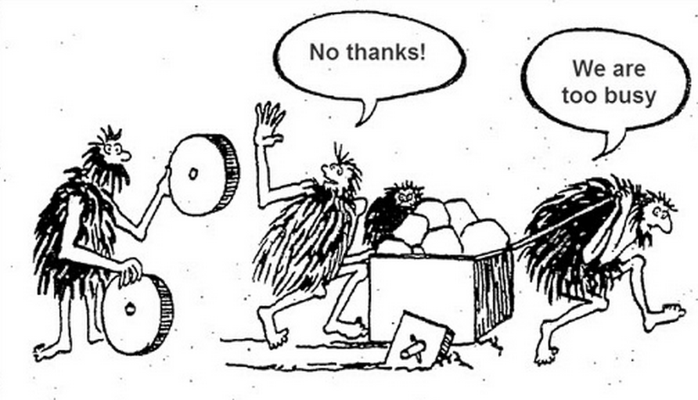
If you want sustained success for your startup, if you want to maximize your revenue, then you’ll have to get comfortable with interrupting people.
You’ll have to pick up the phone, walk in the door, send an email or text message, or ping a prospect on LinkedIn, Twitter, Google+ or Facebook.
You’ll have to interrupt someone who isn’t expecting you to contact them (i.e. you don’t have an appointment with them and they aren’t waiting for you to call or write) and with whom you aren’t currently engaged in a sales discussion.
It might be a new business that you’ve stopped by to qualify or a prospect you met at a trade show.
It could be a prospect who filled out one of your web forms or downloaded your latest white paper. Or someone who just connected with you online.
It could be an old customer you’re trying to reactivate or a prospect in your defined database.
No matter what the circumstances, the simple fact remains that you have to interrupt their day to talk about something you want them to hear, do or buy – and you won’t have a scheduled appointment with them to have that conversation.
Mindset 5: Less is more
Be precise: do less, do good.
Simplicity and focus are the keys at this stage. Don’t scale up for the sake of it; instead, figure out what works so you can focus on scaling that up.
To put it another way: you need to think like a monk.
Monks believe that “less is more” – and I totally agree with them. The same goes for your marketing and lead generation.
Many people believe that you have to constantly do a lot and fine-tune a lot. Sure, if you’re a big business like General Motors or a Tesla or an Apple, then you need to think like that.
But when you’re really small and just starting out, you don’t need to be thinking about and doing lots of things. You just need to do a few things and do them right.
In essence, less is more.
That’s why, at the start, I focus only on things that generate high-quality touchpoints to learn from your ideal customers and offer maximum chances of conversion with minimum effort.
I tell nearly all the companies I work with not to waste their focus on anything that isn’t cheap, doesn’t provide instant results or feedback, and isn’t hyper-targeted to their Ideal Customer Profile (ICP).
For example:
- PR/News – can be too much effort, slow results, and highly untargeted.
- Offline physical promotions – can be too costly, too limited, and hard to measure results.
- Startup events and competitions – can be too much effort, highly untargeted, and meeting potential “experts” who aren’t your target customers. If you’re bootstrapping and there’s a cash prize, by all means, go there to win. But it won’t help you generate good leads.
- Tradeshows – can be too expensive, too much work, and not targeted enough.
- TV/Radio – can be too expensive, too much work, not targeted enough.
- Listing websites such as Product Hunt – can be too much work. You get signups from startup enthusiasts and generally curious people, rather than your ideal customers.
Last but not least, you can only scale what works. As Paul Graham, founder of Y Combinator, recommends to all his early-stage startups, “Do things that don’t scale.”
Don’t automate things unless you know what exactly is working.
A startup has reached product-market fit, has predictable sales, and is ready to scale when it can fill in and prove the following statement:
If today you reach out to [x number] of [potential customers] with [a message], you’ll have [y sales] in [z days] with [a, b, and c steps] in your sales funnel, for [a solution] that helps them achieve [success] by solving [a problem] they have while having your [AARPU] more than [CAC].
Mindset 6: Sales is Science
Sales is a science.
Just like you engineer your product into existence, you need to build a sales and marketing machine to help people see how your product changes their life for the better.
For everything you do, whether you know it or not, you follow a process – whether it’s something mundane such as getting dressed and reaching the office, or something subjective such as how you review a job application.
Many of the processes we follow in life are funnel processes. The funnel concept is the bedrock of sales science.
If you have to choose one thing to master that can maximize the chances of your success – I would say focus on the creation and optimization of funnel processes.
For example, let’s say you’re recruiting and want to hire a sales VP. One way to do so is to think about the process as a funnel. At the broad top of the funnel would be the outreach – you send out hundreds of emails to potential candidates. Then, about 50 of them respond, so the funnel gets narrower.
Of those, only 20 are genuinely interested; and out of those, 5 make it past the phone screening. Through interviews, you identify 2 exceptional candidates and finally make an offer to one of them.
The point is that to get to that one great candidate (at the narrowest end of the funnel), you had to begin by sending hundreds of emails (at the widest end of the funnel).
This is an excellent approach for sales as well – have a look at the funnel snapshot below.
Remember, you don’t need to reinvent the wheel.
If you study what successful people and companies do, you’ll find patterns. And if you duplicate those patterns, you’ll also be able to duplicate their success.
Mindset 7: Attitude is everything
As a founder, your mindset is the foundation of your startup’s success.
Attitude is everything. Your enthusiasm and passion are key – and that’s what people say “yes” to, more than anything else.
If you’re super excited about your product, that’ll rub off on your prospect and they’ll likely buy from you.
Of course, you need to genuinely believe in your product for it to work.
On the flip side, a negative attitude is also a self-fulfilling prophecy.
So, every day, before you set off to sell your product, get yourself in the right frame of mind. Don’t dwell on past failures – commit to focusing on the present.
A positive attitude will give you the highest productivity.
Have a look at these seven key mental traits for success, from the Fanatical Prospecting book by Jeb Blount:
- Optimistic and enthusiastic: Fanatical prospectors have a winning, positive mindset.
- Competitive: They view prospecting through the eyes of a fierce competitor. They’re hardwired to win and will do whatever it takes to stay on top.
- Confident: They approach prospecting with confidence. They expect and believe they’re going to win
- Relentless: Fanatical prospectors have a high need for achievement. They pull out all stops to reach their goal. They never, ever give up, believing that persistence always wins.
- Thirsty for knowledge: They welcome feedback and coaching.
- Systematic and efficient: They have the ability to execute with near-robotic and systematical efficiency.
- Adaptive and flexible: Fanatical prospectors have acute situational awareness. Because of this, they’re able to respond and adapt quickly to changing situations and circumstances.


